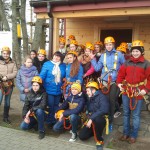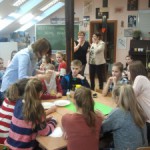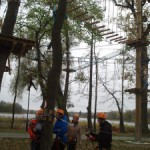W dniach 22-24 października oraz 5-7 listopada 2014 roku Urząd Miasta Ełku gościł dwie ostatnie grupy młodzieży z Ozierska, które aktywnie spędziły czas w Ełku w ramach projektu „Rozwój turystyki aktywnej płaszczyzną polsko – rosyjskiej współpracy” współfinansowanego ze środków Unii Europejskiej w ramach Programu Współpracy Transgranicznej Litwa – Polska – Rosja 2007 – 2013.
Dzięki uprzejmości Gimnazjum nr 4 w Ełku, Gimnazjum nr 1 w Ełku oraz Miejskiego Ośrodka Sportu i Rekreacji w Ełku udało się zorganizować atrakcyjny pobyt dla rosyjskiej młodzieży. W trakcie pobytu dzieci miały możliwość wzięcia udziału w integracyjnych zajęciach edukacyjnych, sportowych i plastycznych podczas spotkań z młodzieżą polską w ełckich szkołach. Młodzież sprawdzała również swoje możliwości w ełckim parku linowym i na basenie. Młodzież z ostatniej wymiany miała także możliwość skorzystania ze ścianki wspinaczkowej zlokalizowanej w hali sportowej przy Szkole Podstawowej nr 2 w Ełku. Ciekawą atrakcją był również spacer po Ełku, wizyta w Muzeum Kropli Wody oraz gra w kręgle.
W ramach projektu realizowanego we współpracy z miastem Oziersk z Obwodu Kaliningradzkiego odbyło się 10 wymian polsko-rosyjskich, w których w sumie wzięło udział 183 uczniów. Wymiany były bezpłatne, wszelkie koszty z związane z transportem, wizami, noclegami i wyżywieniem zostały opłacone z projektu. Dla większości uczniów był to pierwszy zagraniczny wyjazd i jednocześnie pierwsze spotkanie z inną kulturą. Pomimo barier językowych młodzieży udało się znaleźć wspólny język i nawiązać międzynarodowe przyjaźnie.
Poza wymianami w ramach projektu w obu miastach powstały parki linowe, opracowany został Międzynarodowy Program Rozwoju Turystyki dla miasta Ełk i miasta Oziersk oraz powstała wielojęzyczna strona internetowa pełniąca rolę zintegrowanego systemu informacji turystycznej obu miast.


